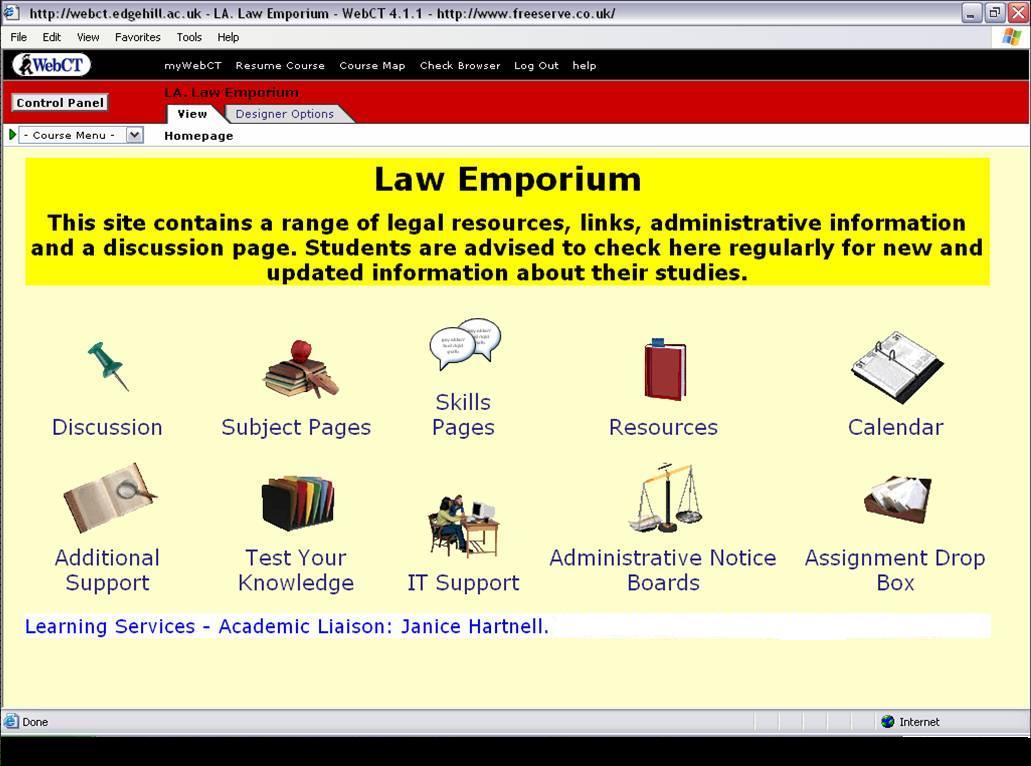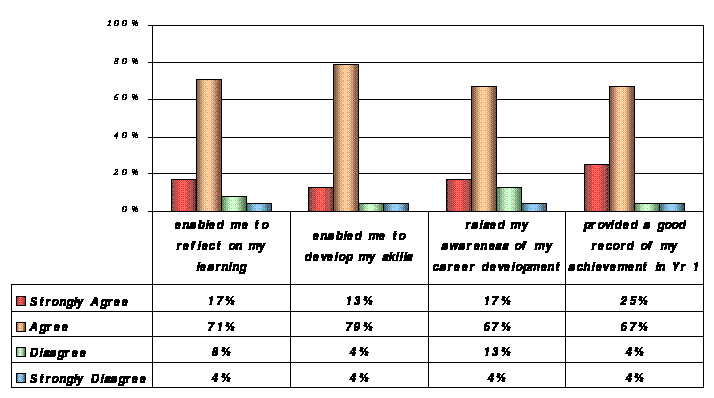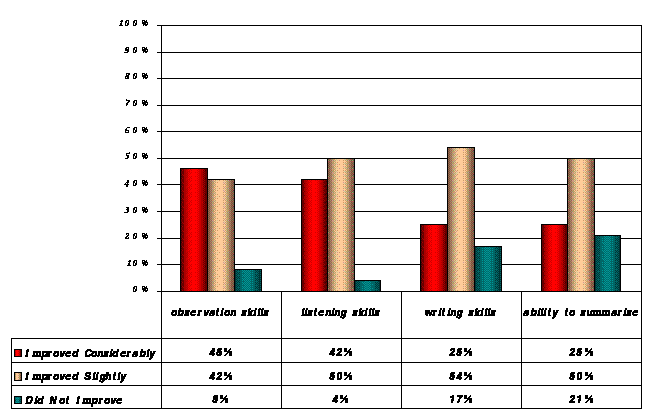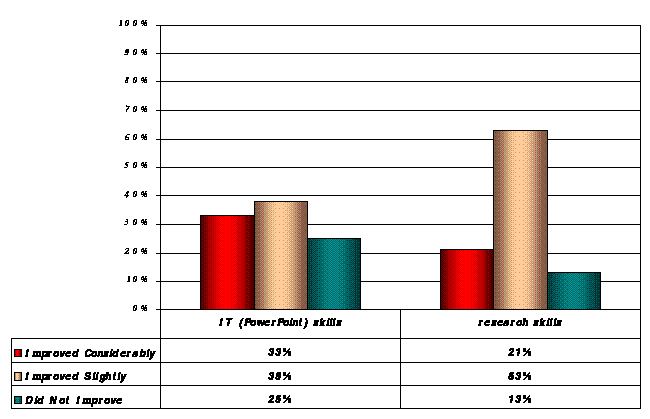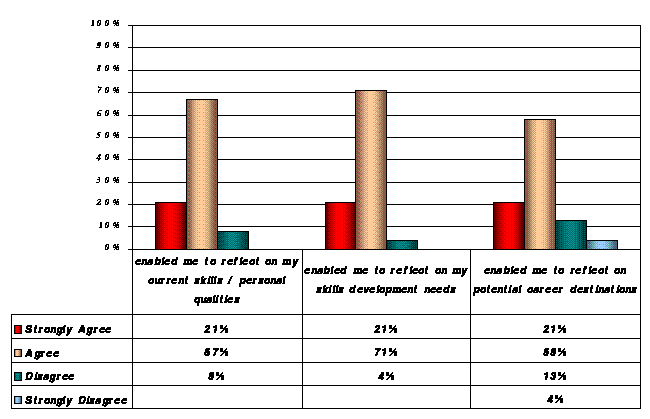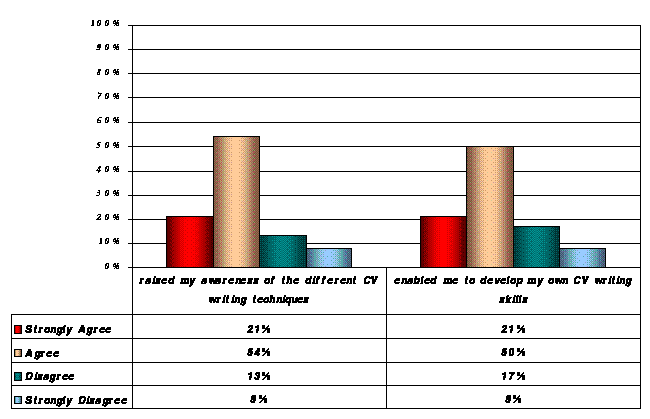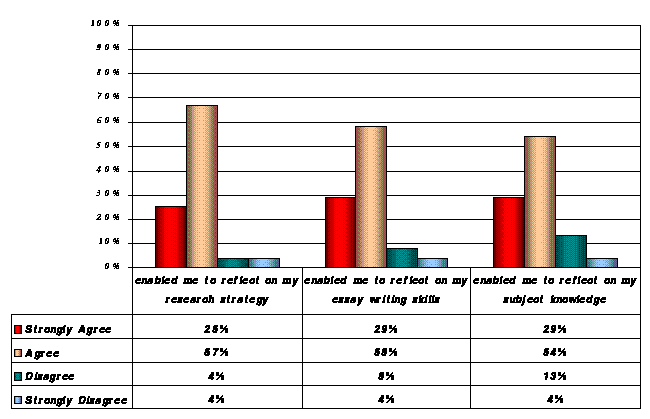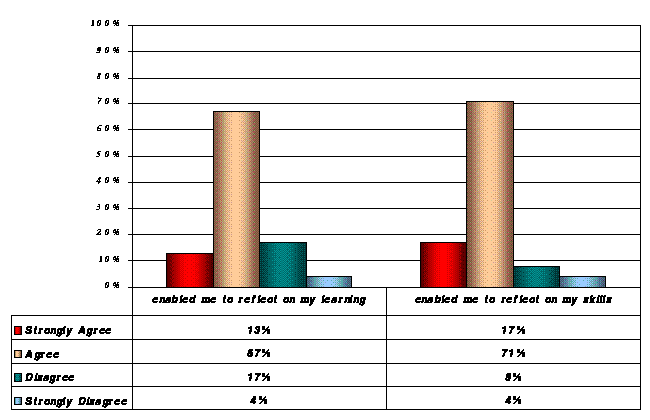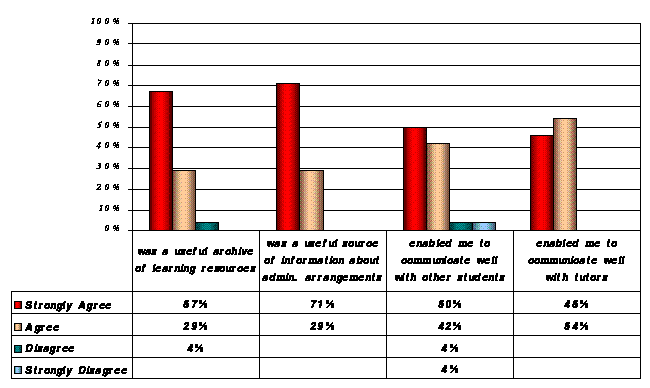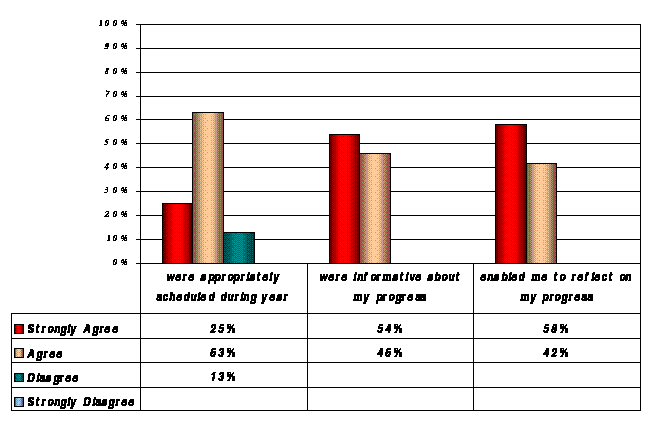JILT 2007 (1) - S Bloxham & A Cerevkova
ISSN: 1361-4169Reflective Learning, Skills Development and Careers Management Online – An Evaluation of a First Year Law Module Sefton Bloxham
|
||||||||||||||||||||||||||||||||||||||||||||||||||||||||||||||||||||||||||||||||||||||||||||||||||||||||||||||||||||||||||||||||||||||||||||||||||||||||||||||||||||||||||||||||||||||||
1. Pedagogic Rationale |
|
|
The main impetus for the introduction of PDP into UK HEIs can be traced back to the 1997 Dearing Report on Higher Education, which proposed the introduction of Progress Files for the recording of student achievement as “a means by which students can monitor, build and reflect upon their personal development” 1 . Subsequently, this was endorsed by the joint UUK-SCOP-QAA Progress File Policy statement of 2000 2 , which required all UK HEIs to introduce “opportunities” for Personal Development Planning by 2005-06, as a “structured and supported processes to develop the capacity of individuals to reflect upon their own learning and achievement, and to plan for their own personal educational and career development”. |
1 |
|
Clearly, the thinking behind the Dearing recommendations was concerned with issues of career development and employability in an era of widening access to higher education. However, the policy of the subsequent joint statement also recognises and enables the development of PDP as a mechanism for enhancing student learning through personal development and reflection. HEIs have been granted relative autonomy in the manner in which PDP is implemented and it is this enabling, rather than regulatory, feature that has led Jackson to conclude that it encourages “people and institutions to think for themselves to avoid the compliance culture…”, arguing that it requires “interpretation, discussion and reasoned argument to make it work” and that it demands “diversity and customisation”< sup> 3 . PDP, therefore, has the potential to address two important issues at the core of higher education in the 21 st century: the development of learners’ skills to enhance their employability and the development of learners’ reflective abilities to enhance their ability to learn. In the specific context of legal education, the Law Benchmarks 4 identify subject-specific, general transferable intellectual and other key skills which have been part of the Qualifying Law Degree (QLD) curriculum for some years. However the task of developing learners’ abilities to reflect on, and learn from, their own learning experience is one which has attracted less attention. The integration of skills development and reflective learning within a PDP programme thus presents a significant challenge. |
2 |
|
In the context of an HEI that places widening access and employability at the core of its mission, this challenge is of particular importance because both skills development and personal development opportunities have been identified as key factors in improving retention rates of “non traditional” students 5 . A HEFCE study of nine HEIs that had been successful in dealing with student diversity identified “curriculum-linked opportunities for student personal development” and “early assessment of students’ skills and needs” as being key ingredients in that success 6 . More recently, a survey of six UK universities performing above their benchmarks for widening participation, retention and completion, identified, inter alia, the “integration of skills development, employment and careers education, and personal tutor systems” as areas of practice associated with success in this respect 7 . Both these studies also identify further features of successful strategies that improve retention rates, namely recognition of the importance of a co-ordinated approach involving both academic and support staff 8 and “a student-centred institutional approach aimed at enhancing students’ sense of belonging and academic, social and cultural inclusiveness through high quality teaching and effective student support involving all staff in the institution” 9 . |
3 |
|
However, a number of studies have identified particular challenges to the successful implementation of PDP. Probably the main challenge is that of overcoming the scepticism of both learners and academic staff, neither of whom may see the value of PDP 10 . Studies have shown that students often fail to relate to institutional descriptions of the skills that are required to be developed and do not always see the relevance of “add on” skills modules that are not embedded within the curriculum of their chosen subject 11 . As we identify below, variable levels of student participation in our own institutional PDP programme tend to support this view. The lack of enthusiasm of academic staff is explained by very different factors though, as East’s study of the implementation of PDP in the law school at Glamorgan University indicates 12 . Here, the main problem was identified as being a failure to properly resource the personal tutor system, upon which an embedded PDP programme relies. In addition to the resource issue, many academic staff do not regard the employability focus of PDP as being central to their role 13 . Furthermore, the fact cannot be ignored that, for most academic staff, promotion and career prospects hinge on research output rather than on teaching innovation and support. In this respect there may be significant differences between pre-1992 and post-1992 institutions which may have implications in terms of the models adopted in the respective types of institutions. In either case, the implementation of any PDP programme needs to be preceded by an institutional commitment to investment in appropriate staff development as well as the provision of adequate resources in support of a robust personal tutor system, combined with more relevant and transparent exposition of the benefits it will provide for students. |
4 |
|
Despite the difficulties discussed above, thre is evidence from case studies within legal education that suggests it is possible to develop and implement PDP programmes successfully. East’s study concluded that, despite the resource and IT problems, there was overwhelming approval from students who saw the value of progress files. Prince’s earlier study of the introduction of an online PDP programme (PESCA) at Exeter University law school also identified a high level of IT related problems but nevertheless concluded that students who had not experienced such difficulties were positive in their evaluation of its usefulness. Interestingly, over 90% of students had used PESCA for the purpose of preparing an evaluative report which, in conjunction with tutor reports on tutorial performance, formed part of the assessment 14 . The importance of embedding PDP within the assessment structure is also emphasised in the study of the use of progress files at UCE law school, which also concluded that the benefits outweighed the costs of implementation 15 . |
5 |
|
Ward, in his review of the LTSN case studies, suggests that an approach which may overcome some of these problems is to embed PDP within the existing subject curriculum in a way which is both meaningful to learners and which supports and enhances the study of the subject matter itself 16 . To a large extent, such an approach is supported by the inclusion, and identification, of skills in the Law Benchmarks. However, one potential problem in this respect has been identified, namely that there may be reservations or even opposition on the part of academic staff to the embedding of PDP on Level 3 modules where a higher level of engagement with the subject matter is required to achieve learning outcomes 17 . The same authors also identify the need to integrate Careers Service staff into PDP programme implementation, which may present further problems within a higher education culture where such collaboration between academic and support staff has been limited. |
6 |
|
Both the case studies at the Universities of Glamorgan and Exeter identify IT problems as being one of the key obstacles to success. However, this potential problem needs to be set against the evidence that creative use of ICT applications can enhance the student learning experience, as well as promoting improved skills development and reflective practice. It has been argued that the use of hypermedia and web-based resources enables interactivity and/or more active learning which can lead students to take “ greater responsibility for their own learning” and to adopt “ reflective learning attitudes” 18 . A more detailed exposition of the research evidence that supports this view can be found in an earlier paper which sought to present a rationale for the adoption of a wider ICT strategy for the overall delivery of the present LLB programme at Edge Hill 19 . |
7 |
|
To summarise, the literature on PDP suggests that the processes of recording achievement and engaging in personal development planning can support the twin purposes of heightening learners’ awareness of their skills development for career planning purposes and of developing a more reflective approach to their learning of the curriculum content. However, against these benefits, a number of potential difficulties have been identified – lack of understanding of the purpose of PDP on the part of learners; scepticism about its purpose on the part of academic staff; inadequate resourcing of personal tutor systems which are needed to support the process; cultural opposition to, or at least unfamiliarity with, a collaborative approach by academic and support staff; IT problems. It was with these possibilities and challenges in mind that the authors, in collaboration with the Careers Service, Learning Services and Learning Technology staff, embarked on the process of designing and implementing an embedded PDP programme, delivered through a combination of classroom teaching and online delivery through the VLE, within a first year law module for the 2005-06 academic year. The remainder of this paper describes that process, evaluates the results and reflects on the experience. |
8 |
2. Institutional Background |
|
|
Edge Hill University has only recently, in May 2006, become a university in its own right, having been granted taught degree awarding powers (TDAP) a few months earlier. Previously the institution was known as Edge Hill College of Higher Education and its degrees were validated by Lancaster University. The first year of study on the LLB programme, which began in 2003, consists of four, 30-credit modules (Legal Methods and Systems, Constitutional and Administrative Law, Contract Law and Tort Law), three of which are assessed through a combination of essays, problem questions and examinations. The Legal Methods module, the focus of this paper, was originally assessed via an essay with research summary sheet, an oral presentation and an examination. Although students were supported by an institutional induction programme, there was no dedicated induction programme within the LLB, the skills being developed explicitly through the Legal Methods module. Alongside this was an institutional PDP programme, supported by the personal tutor system. Although not formally assessed, students were required to complete this in order to matriculate to Year 2. A feature of the personal tutoring system was that all academic staff were allocated a number of tutees regardless of whether they taught the student in Year 1. Two years experience of the LLB revealed three main problems which were identified as: the longitudinal problem, the PDP problem and the assessment problem. These problems are discussed in detail below, together with an exposition and evaluation of the approach that has been adopted to overcome them. |
9 |
3. Problems (Challenges) of the Existing Institutional and Departmental Structures |
|
|
As has been indicated above, certain problems associated with the lack of a dedicated legal skills induction programme and the “ bolt on” nature of the institutional PDP programme had been identified with the existing structure of the LLB programme. The three main problems, which will now be addressed, were identified as follows: the longitudinal problem, the PDP problem and the assessment problem. 20 |
10 |
3.1 The Longitudinal Problem |
|
|
The longitudinal problem arose due to the lack of a dedicated induction programme. Because the skills workshops ran longitudinally within the Legal Methods module, it became evident during the first month of the first semester that the lack of certain skills was acting as an obstacle to student progress within other modules. For instance, tutors on the three substantive law modules required students to demonstrate both research skills and subject knowledge at a point before Legal Methods could cover them. For example, students were expected to locate and read case law and appreciate the rules on statutory interpretation and judicial precedent before these topics had been adequately dealt with in Legal Methods. This problem was compounded by two further issues. First, primary LLB resources are held almost entirely in electronic format. Consequently the early stages of the Legal Methods module needed to concentrate on ICT skills. Second, many of the students recruited to the programme were from non-traditional backgrounds and basic academic skills were lacking. Consequently, before Legal Methods could adequately cover the basics of the English legal system, it needed to first focus on basic skills such as ICT training, including workshops on basic word-processing and email management; legal research skills, including the use of electronic databases and the internet for legal information retrieval and the use of IOLIS courseware. Given these problems, it became clear that the Legal Methods module, delivered longitudinally, was unable to meet the skills requirements of the other modules. |
11 |
3.2 The PDP Problem |
|
|
On entry to the programme students were allocated a personal tutor drawn from academic staff. First year students followed an institutional PDP programme, customised for the LLB programme in 2003, which consisted of five elements. Section 1 required students to complete personal details and meet with their personal tutor in week 1 of the programme. Section 2 required reflection on the newly introduced induction programme 21 , completion of an individual skills audit and a meeting with their personal tutor to discuss matters arising from their first month in higher education. Section 3 required reflection on Semester 1 generally, including reflection on assignment feedback and the production of a CV which was discussed at a December personal tutor meeting. Section 4 was designed to encourage further reflection on assignment feedback with a further meeting being held within the first two months of the second semester. Section 5 required reflection on Year 1 performance and the production of an updated CV. At this meeting the student’s progress file was signed off by the personal tutor. As the PDP programme was not embedded into a Year 1 module it was treated, for the purposes of the end of year examination board, as a free standing module coded as either 100% or 0%. The central problem with this was the perception of students that PDP lacked relevance. It was seen as an additional task for which no reward accrued and consequently it received a low status. With a strong institutional focus on employability, widening access and improving progression/retention rates, it was clear that the current PDP programme was not fulfilling its function. Experience institutionally suggested likewise and consequently a decision was taken at Faculty level to request departmental ownership of the PDP process and the embedding of it into an appropriate module. |
12 |
3. 3 The Assessment Problem |
|
|
The assessment problem was closely linked to the PDP problem. The focus of the existing PDP on skills and career planning was not satisfactorily linked to the curriculum with the result that there was little alignment of the learning activities, the learning outcomes and the assessment tasks on the Legal Methods module. An opportunity existed for the Legal Methods module to develop subject knowledge which was linked more closely to the goals of the PDP. To achieve this synthesis, the assessment strategy needed redesigning. Whilst the oral presentation was fit for the purpose of enhancing verbal communication skills, the essay and examination were ill equipped to develop the subject specific abilities, general transferable intellectual skills and key skills stated as learning outcomes in the module validation documents. |
13 |
4. Implementing Changes |
|
|
In order to affect the necessary changes to the Legal Methods assessment strategy, a partial revalidation of the module was required. The documentation submitted to the relevant committee articulated the rationale for the proposed changes in the following terms:
|
14 |
|
As the principle of embedding PDP within an appropriate Year 1 module had already received institutional support, discussion within the committee focussed on the substance of the proposal with the result that the following changes to the Legal Methods module were approved: |
15 |
4. 1 A Revised Personal Tutoring System |
|
|
An important change to the Year 1 personal tutoring system was accepted. Rather than all academic staff acting as Year 1 personal tutors, the decision was made to allocate Year 1 LLB students to the five staff who taught on the Year 1 programme. With student enrolment currently less than 50, the resource implications were manageable, although this may need to be reviewed in the future. The rationale behind personal tutor marking was to forge a stronger link between the personal tutor and the personal tutee. In previous years implementation of the PDP had become burdensome for staff, particularly in relation to students missing scheduled meetings. With personal tutor meetings now timetabled and with tutors being able to offer assignment grades and feedback, it was anticipated that personal tutor meetings would receive a higher priority amongst the student body. It was also expected that by more closely tracking student progress throughout the year, personal tutors would acquire a much better understanding of their tutees. This, it was hoped, would ease the transition into higher education and contribute to improved retention and progression rates. However, as a consequence of the new personal tutoring system, students would need to switch their personal tutor when entering Year 2 in order to avoid overloading the Year 1 tutors with tutees. Personal tutor continuity would therefore be lost, although it was anticipated that this would be outweighed by the advantages of a more robust Year 1 personal tutoring system. 23 |
16 |
4.2 Reflective Practice Log (RPL) |
|
|
The Reflective Practice Log replaced the essay. The RPL assessment encourages legal skills development and self reflection on learning and performance. It comprises of: (1) an induction programme key skills audit related to subject specific research, which takes the form of a WebCT skills quiz that tests students’ online library/research skills; (2) a 600 word court visit exercise designed to expose students to court proceedings and encourage reflection on issues such as the unrepresentative make up of the judiciary and legal profession; (3) a research log comprising of a detailed account of the research and writing methodologies used in the production of a formative essay located in one of the other Year 1 modules; and (4) a 600 word ‘assignment reflection’ exercise to be submitted at the end of semester 2 and designed to encourage reflection on Year 1 performance. The combined value of the Reflective Practice Log is 40%. In order to satisfy essential competency requirements, reassessment of RPL 1 was permitted throughout semester 1. |
17 |
4.3 Careers Management Portfolio (CMP) |
|
|
The Careers Management Portfolio, which was designed in conjunction with the Careers Service, replaced the exam. An existing feature of their service was an optional certificate in careers awareness which was available to all students on completion of a number of generic careers related tasks 24 . The basic structure of this certificate was maintained but the tasks were specifically tailored to the legal profession, thus establishing a strong link between the curriculum (subject knowledge) and PDP. The CMP is comprised of three parts: (1) the production of a power-point presentation on the nature and structure of the legal profession and the qualifications, skills and personal qualities required for work within it. This is supported by WebCT resource pages with links to legal services and other legal careers materials; (2) a legal/personal skills audit covering the students’ current skills position, which leads to the production of a 1000 word reflective essay and an initial skills/careers development plan. This is supported by WebCT resource pages including links to sites containing online skills audits such as Prospects 25 and Windmills 26 ; (3) the production of a curriculum vitae which is designed to encourage early recording of, and reflection on, achievement. Students wishing to acquire the institutional careers certificate are required to complete a fourth element (on interviewing and assessment) which has been integrated into the Year two LLB PDP. The value of the Careers Management Portfolio is 30%. |
18 |
4.4 Oral Presentation (OP) |
|
|
The oral presentation was the only feature of the existing Legal Methods assessment strategy to survive the partial revalidation. The oral presentation requires students to research a problem question linked to the curriculum and deliver presentation on the issues contained within it. Students are then exposed to a short question and answer defence of the presentation. The value of the oral presentation is 30%. Whilst the oral presentation is designed to assess curriculum knowledge, it also develops general transferable intellectual skills and key skills and exposes students to an environment akin to an interview. |
19 |
5. Supporting WebCT Infrastructure |
|
|
As has been indicated in the preceding section, a decision was taken to make full use of a virtual learning environment (VLE) – in this instance, the institutional WebCT platform - to provide an online supporting infrastructure for delivery of the new, embedded, PDP programme. This decision clearly was not without inherent risks, as the case studies of the experience in law schools at the universities of Glamorgan, Exeter and Central England have shown 27 . However, those experiences need to be set against the evidence from elsewhere of the potential benefits of the creative use of ICT applications to support skills development and reflective learning 28 . |
20 |
|
Positive student feedback on the use of ICT in the delivery of their undergraduate law programmes can be seen from research conducted at Coventry University 29 and at Lancaster University 30 . The Coventry study also reported improved skills development, a feature that was also identified in an earlier study at Lancaster 31 . These conclusions are further supported by research on postgraduate programmes at Glasgow Graduate School of Law 32 and undergraduate programmes at Glasgow Caledonian University 33 , where it was found that the use of multi media learning resources had a beneficial effect on the skills development of postgraduate students. An earlier study of undergraduate students at Wolverhampton University 34 had also concluded that online delivery can contribute to improved levels of achievement for weaker students, even when the assessment criteria was designed to reward deep, as opposed to surface, learning. These studies provide convincing evidence of the potential advantages of using appropriate ICT applications to support and enhance student learning and it is against this background that the teaching team decided to deliver the new PDP programme through the institutional VLE – the WebCT platform. |
21 |
|
However, the studies cited above were all conducted in the context of existing modules where the main focus was on curriculum content and skills development. None of the studies involved the development of PDP either within those modules or as independent modules. Nonetheless, there were additional reasons to believe that the use of a VLE might enhance the delivery of the new PDP-embedded module. One advantage was perceived to be in the ability to track and monitor student participation and involvement through the WebCT facility. This ability to track performance has been identified as one of the factors that impacts on non-traditional students’ ability to integrate into the HE culture and achieve academic progress, thus supporting improved retention rates 35 . A further advantage was seen in the ability to create online tests and quizzes, which would enable tutors to undertake early assessment of students’ skills and needs, and to provide appropriate formative feedback. Both of these factors were identified in the HEFCE study 36 as improving the performance of non-traditional students and supporting improved retention rates. Consequently, despite evidence that “IT problems” were often one of the major obstacles to the success of PDP programmes, it was felt that by using the tried and tested WebCT platform, which all staff had experience of using, the risk of such problems emerging would be minimised and the potential benefits would hopefully be demonstrated. |
22 |
|
As has already been indicated, both institutional and departmental policies promote the use of WebCT for the support of all modules, as part of a broader strategy to encourage more flexible, student-centred, learning. Originally, WebCT acted primarily as a source of access to all necessary learning resources. However, the tutors felt that this did not engage students sufficiently with the subject of law and did not allow for the reflection or appropriate skills development that was required for an effective PDP programme. The changes described above represent a more proactive approach involving the use of WebCT to support skills development, reflective learning and personal development planning in a number of ways and at various levels. This is achieved by provision of: (1) learning and teaching resources, including interactive discussion forums for learning support; (2) online formative and summative assessment and feedback; (3) an administrative structure for tracking student engagement, performance and progress; (4) a mechanism for the creation of student records of achievement. |
23 |
5.1 Learning and Teaching Resources |
|
|
The foremost, and perhaps most employed, characteristic of WebCT is that it provides online access to all necessary course resources, including the general module information, lecture handouts, seminar materials, and the assessment instructions and criteria. This ensures that students have access to all course materials at times and locations appropriate to their personal circumstances. |
24 |
|
Another important feature of WebCT is that it acts as a tool for continuous communication between students and personal tutors, as well as communication amongst students themselves. Interactive discussion forums have been created to provide online support and to encourage collaborative learning and active student participation and involvement with the subject. Provision of messages in a form of banners on the module homepage ensures that students do not miss necessary information and the latest updates. |
25 |
|
One of the advantages of WebCT is that it can provide students with access to all necessary resources in one place. Additional resources have been created in collaboration with the Careers Service, Learning Services and Learning Technology staff. The module is linked with the Law Emporium pages, which are maintained by the Learning Services staff 37 . The Law Emporium provides additional learning resources, including learning support pages, skills pages, and IT support, as well as a range of legal sources, subject pages, ‘test your knowledge’ quizzes and crosswords, and links to relevant legal and study sites. Finally, administrative notice boards and discussion forums enable not only Year 1, but all law students to interact and support each other. |
26 |
| Picture 1: Law Emporium WebCT site
Online Assessment and Feedback |
|
|
WebCT enables tutors to assess student coursework online and to provide almost immediate feedback in an electronic form. Assessment pages contain all necessary information about the assignments, including the assessment instructions and criteria. In addition to paper submissions, students are also required to submit their coursework via the Assignment Drop Box facility. All module assignments are marked by Year 1 personal tutors 38 . |
27 |
|
For the Reflective Practice Log 1 39 , an interactive quiz was created, consisting of a combination of multiple choice and short answer questions. This enabled students to complete, and tutors to mark, the induction skills audit exercise online. Although the creation of such a quiz was time consuming, it ultimately resulted in easy completion and submission. Once the quiz was assessed, feedback was immediate. There was no need for tutors to provide feedback because the answers were incorporated when the quiz was created, this saving tutors’ time when assessing students’ answers. Inclusion of the html links within the quiz meant that students had instant access to the Westlaw and Lexis-Nexis databases, electronic law journals and related online legal sources. An additional advantage of the quiz tool was that there was no need to upload and download the Word documents, using the Assignment Drop Box. Finally, online completion of the quiz enabled students to develop their ICT and legal research skills. It is essential that students possess these abilities, as library holdings of primary sources of law and academic journals are almost exclusively electronic. |
28 |
|
In collaboration with the Careers Service 40 and Learning Technology staff, separate online ‘content pages’ have been created for the Careers Management Portfolio 41 . These summative assessment exercises are, apart from an introductory lecture, delivered and completed entirely online and comprise of three sessions. Each online ‘content page’ comprises of the session aims and learning outcomes, the assessment instructions and criteria, and the relevant resources, including additional links to various online legal careers sources and self-assessment skills audits. Again, the assignments are submitted via the Assignment Drop Box and are marked by personal tutors. Marks are released and feedback from tutors is returned electronically prior to personal tutor meetings. |
29 |
5.2 Tracking Student Engagement and Performance |
|
|
The ‘Track Students’ tool on WebCT enables tutors to monitor student usage and engagement with the pages. This identifies the extent to which students access the relevant learning resources and discussion messages as well as their level of engagement with those discussions. This is monitored by personal tutors and discussed with their tutees during the personal tutor meetings. This is a valuable tool for tutors, as it enables them to track student involvement beyond the level of traditional indicators of performance. The importance of this tool is further underlined when one takes account of the fact that WebCT is also extensively utilised as an administrative notice board for the communication of urgent notices and updates, making it essential that students access WebCT on regular basis. The latest figures show that students visit this module’s resources often. The hits range from 270 to 1,232, with an average of 532 hits per student. The usage statistics demonstrate the popularity of WebCT with students and confirm its importance as a learning support tool. |
30 |
|
In addition to moderating student engagement with WebCT, the ‘ Manage Students’ tool enables tutors to track student performance on two fold basis: an individual student progress, as well as overall assignment and/or module performance. Tutors are able to collate individual student marks and if needed, to intervene at early stages. Student progress is regularly discussed at personal tutor meetings. The overall assignment and/or module performance page provides records of the highest, lowest and an average mark. This, amongst other things, enables tutors to reflect on and evaluate the assessment criteria and to ensure that same marking standards are employed by all Year 1 personal tutors. |
31 |
5.3 Student Recording of Achievement (Progress Files) |
|
|
Student marks for their assignments are released via the Assignment Drop Box. This enables students to keep track of their own performance and to record their achievement. Since all assignments and exercises are submitted electronically, students have access to their work online and in one place, although they are also encouraged to copy their files to a disc, CD or hard drive. In addition, the advantage of the ‘My Grades’ facility is that students are able to see all their marks for individual modules in one place and at the same time. Finally, RPL 4, the assignment reflection exercise 42 , provides students with a record of their progress, summarising their achievement across all Year 1 modules in one document. This forms the basis for their Progress File in Years 2 and 3. |
32 |
|
To summarise, it has been demonstrated that WebCT plays an important role in supporting the module and provision of PDP for Year 1 programmes. It not only provides access to learning and teaching resources, but it also enables tutors to assess students and provide feedback online and to track student progress. Finally, and most importantly, it encourages active student participation and reflective learning as well as providing a mechanism for students’ recording of their achievement. |
33 |
6. Student Evaluation |
|
|
The main evaluative element is based on student feedback, both quantitative and qualitative, that was gathered on completion of the module in April 2006. This, together with more recent data on student performance and achievement and the reflective evaluation of the tutors, provides some indication of how successful the programme has been in achieving its aims and of what issues remain to be resolved. |
34 |
6.1 Overall Programme |
|
|
Students were asked to complete a questionnaire relating to their overall experience of the PDP programme. Questionnaires were completed by 24 of the 32 full-time students who were enrolled on the LLB programme at the time - a response rate of 75%. The first question asked about satisfaction ratings for the overall programme. Responses were generally very positive, with most students “agreeing” or “strongly agreeing” that it had enabled them to reflect on their learning (88%), that it enabled them to develop their skills (92%), that it raised their awareness of career development issues (84%) and that it provided a good record of their achievement (92%). |
35 |
|
It is also clear from some of the student comments that the programme was valued and that students were able to recognise the developmental value of certain aspects of the programme:
|
36 |
|
Chart 1: Evaluation of the Year 1 PDP Programme
Sample: 24 responses |
|
6. 2 Skills Development |
|
|
The questions relating to skills development were designed to identify particular skills and relate them to specific learning tasks that had been undertaken during the course of the programme. Responses were generally very positive, with between 67-92% claiming that the learning task had “slightly improved” or “ considerably improved” the relevant skills. However, as is indicated in the charts below, there are variations in the students’ perceptions of how successful different aspects were in achieving the intended learning outcomes. Interestingly, the two aspects that were perceived as being the least helpful were the development of PowerPoint skills (CMP1) and the development of oral presentational skills through the Oral Presentation. Interestingly, this was the one element of the assessment structure that had not been changed when this module was re-validated in the summer of 2005 and the tutors had already identified it as an aspect of the module that may need modification for the future.
|
37 |
|
Chart 2: Skills Development – RPL1 (Induction Skills Exercise)
Sample: 24 responses |
|
|
Chart 3: Skills Development – RPL2 (Court Visit)
Sample: 24 responses |
|
|
Chart 4: Skills Development – CMP1 (Legal Profession PowerPoint)
Sample: 24 responses |
|
|
Chart 5: Skills Development – Oral Presentation
Sample: 24 responses |
|
6.3 Careers Awareness |
|
|
The questions relating to careers awareness were designed to identify particular learning outcomes – subject knowledge, reflection on skills/careers, CV development - and relate them to the specific learning tasks that had been undertaken as part of Careers Management Portfolio. Responses were very positive, with between 71-92% “agreeing” or “strongly agreeing” that the learning tasks had developed their subject knowledge and enabled them to reflect on their skills needs and career options as well as developing CV writing skills. It is worth noting that the latter task was the least positively regarded. A final point to note is that a number of students commented that a task considering a wider range of career options, beyond the legal profession, would have been more useful. This is a factor that needs to be addressed although uncoupling the subject knowledge, which would have to remain focussed on the legal profession, from the process of reflection on skills and career options would present difficulties.
|
38 |
|
Chart 6: Careers Awareness – CMP2 (Skills Audit)
Sample: 24 responses |
|
|
Chart 7: Careers Awareness – CMP3 (CV)
Sample: 24 responses |
|
6.4 Reflective Learning |
|
|
The questions on reflective learning were designed to identify aspects of their learning that students had been required to reflect upon – critical thinking, research strategy, essay writing skills, subject knowledge, personal development and academic performance – and relate them to the learning tasks that were undertaken. The learning tasks were primarily drawn from the RPL but it was felt that CMP2 (skills audit) should also be included even though this necessitated some overlap with the questions in the previous section on careers awareness. Reassuringly, the responses in the two different sections are remarkably similar. Overall the responses were again positive, with between 67-92% “agreeing” or “strongly agreeing” that the learning tasks had encouraged/enabled reflection on various aspects of their learning.
|
39 |
|
However, a number of students commented on the difficulties they had experienced in adapting to reflective writing, which is an issue that needs to be addressed and is discussed in more detail later in this paper. 43 .
|
40 |
| Chart 8: Reflective Learning – RPL3 (Research Log)
Sample: 24 responses |
|
|
Chart 9: Reflective Learning – CMP2 (Skills Audit)
Sample: 24 responses |
|
6.5 WebCT |
|
|
The questions on WebCT were designed to highlight the various benefits that are claimed to be associated with the use of a virtual learning environment (VLE) – resources archive, administrative information dissemination, communication tool. This section produced the most positive of responses of the whole questionnaire, with between 92-100% “agreeing” or “strongly agreeing” that the VLE did indeed deliver these benefits. As has already been demonstrated, the decision to use a VLE to support the delivery of the PDP programme has proved popular in terms of student usage 44 and this appears to be strongly endorsed by the students’ own evaluation of its usefulness.
|
41 |
|
Chart 10: WebCT
Sample: 24 responses |
|
6.6 Personal Tutoring System |
|
|
Against the background of high absenteeism rates for personal tutor meetings during the previous academic year, it was crucial to the success of the new programme for these meetings to be meaningful and valuable for students. Consequently, it has been encouraging to see the highly positive responses to the questions relating to these meetings. As is demonstrated by both the quantitative and qualitative data below, students perceived these meetings as very helpful. Indeed, the most common negative response to these questions was the complaint that there were not enough personal tutor meetings.
|
42 |
|
Chart 11: Personal Tutor Meetings
Sample: 24 responses |
|
7. Student Achievement |
|
|
32 full-time students were still enrolled at the end of the academic year. The evidence from the final results for the Legal Methods module suggests that the learning outcomes have been successfully achieved. Of the 29 students who completed all their assignments, all passed the module. The three students who failed to complete the module had been consistently absent from classes throughout the year and failed to submit most of their coursework assignments. This indicates a significant improvement on the previous year when only 35 out of 45 students completed all their assignments, and one student failed despite completing the module. The evidence from the other 3 modules taken in Year 1 shows modest improvements in completion rates, by comparison with 2004-05. However, although these indications are positive, given the small size of the cohorts in both years, it would be premature to draw any final conclusions as to the impact of the new programme at this stage. The increase in the size of the cohort for 2006-07 will provide more substantial data with which to further evaluate its success in twelve months time. |
43 |
8. Tutor Reflection |
|
|
The tutors’ experience of delivering the new module has been educational in itself. Some of the issues that were identified in advance as being potentially problematic, such as the resourcing implications of the personal tutoring system, have in fact been successfully managed, while other issues, such as the moderation of the assessment process, have emerged which have yet to be fully resolved. The following summary of the tutors’ reflections focuses, primarily, on these two aspects. |
44 |
8.1 Personal Tutoring Process |
|
|
As has already been indicated 45 , one of the problems associated with the previous PDP programme was that students did not see it as being important. Consequently, personal tutor meetings to check on progress with the PDP tasks were very poorly attended with the overall co-ordinator of the programme having to spend considerable time chasing up those students who failed to attend throughout the year. This year, by contrast, very few students have failed to attend their personal tutor meetings. It would appear that a number of factors have contributed to this. Firstly, the fact that these meetings were scheduled into the Legal Methods timetable. Secondly, the fact that the personal tutors were discussing students’ assessed coursework at the meetings. Thirdly, students’ improved perceptions of the value of these meetings appear to have also played a part in reducing absenteeism to a minimum. 46 |
45 |
|
From the tutor perspective, the personal tutoring system, which had the potential to place excessive demands on staff resources, has in general operated successfully. The re-structuring, designed to ensure that all Year 1 students were allocated to a tutor who taught on Year 1 modules, has ensured that the potential strain on resources has not materialised. Indeed, by comparison with the previous year, the responsibility for ensuring that students attended personal tutor meetings has been less onerous because, as indicated above, the absenteeism problem has been virtually eliminated. It is also the case that more direct involvement with the process of assessment and general academic progress of the students has given greater relevance and meaning to the meetings for tutors. Nevertheless, some tutors have suggested that a more structured format for those meetings would contribute to ensuring that all students received the same level, and quality, of support for their personal development planning, and at the same time provide a more effective mechanism for quality assurance. |
46 |
|
The original plan 47 was to continue with this strategy of using only Year 1 teaching staff for the immediate future. One potentially adverse consequence of this, due to the balance of numbers between the Year 1 cohort and the Years 2 & 3 cohorts, was that students would have to change their personal tutor at the end of Year 1. However, because of a significant increase in recruitment for the 2006-07 academic session, it has now been decided that all staff will act as personal tutors for this programme next year. This decision is not without its own dangers in that there are staff development implications for those tutors who will be new to, and unfamiliar with, the programme. As will be seen below, this will need to handled with care in the context of the procedures for moderating assessment. |
47 |
8.2 The Assessment Process |
|
|
The assessment process, as has already been indicated, appears to have had a beneficial effect on students’ perceptions of, and attitudes towards, personal tutor meetings. Additionally, despite some concerns at the outset as to whether the assessment structure would subject students to “over assessment”, the results indicate that students have been marginally more successful in achieving the intended learning outcomes and, perhaps more significantly, a higher proportion of the cohort has completed the module. |
48 |
|
However, the tutors’ impressions have revealed one important issue of concern in relation to assessment. The indications at the beginning of the year were that students appeared to be struggling with the reflective writing elements. In many ways this was unsurprising as they were unlikely to have had much prior experience of the genre. Given that one of the objectives of PDP is to develop this particular attribute, this was of some concern. By the end of the year though, it was noticeable that a significant number of students were demonstrating a marked improvement in this respect. This conclusion is also supported by many comments on the evaluation questionnaires which provide evidence of reflective thinking in themselves. However, it is also undeniable that many students experienced difficulties with this form of writing, as indicated in the student questionnaires. Consequently, it is intended to provide additional support and guidance through the provision of dedicated workshops in the initial skills development programme in 2006-07. |
49 |
|
The assessment process has also raised a potentially problematic issue for tutors. Although the “assessment burden” (extra marking) has been managed reasonably successfully, ensuring fairness through the moderation process has, at times, been more difficult to manage. The unfamiliar nature of some of the coursework assignments resulted in some significant differences in marking practice. Although this phenomenon is more widespread in higher education than is generally acknowledged, it may have been exacerbated due to insufficient time being spent in advance on developing a shared understanding and commitment to the objectives of the assignments – a staff development issue. Another possible explanation may be that there is a need to develop clearer and more detailed marking criteria for some of the coursework assignments, in particular those involving reflective writing. Despite these concerns, the problem was partially ameliorated by the use of the WebCT feedback facility which enabled tutors to compare and contrast their own marks with those of other tutors, prior to release of the marks and feedback to students. This process not only enabled the module leader to make adjustments to individual marks as necessary, but also provided transparency as to individual tutor’s judgments about particular pieces of coursework. This issue is especially important when one takes into account the fact that all Year 1 tutors, including those who had no other formal involvement with the delivery of the module, are responsible for assessment. Furthermore, those tutors are marking their own personal tutees’ work. In such circumstances, it is essential that the moderation process operates as a robust and effective quality assurance mechanism. |
50 |
9. Conclusion |
|
|
To summarise, this paper has sought to describe how tutors have developed and implemented an embedded PDP process within a Legal Methods module for first year undergraduate law students. The approach adopted has been located within the context of the research literature that identifies both the pedagogic rationale for PDP and how the use of ICT applications can support skills development and reflective learning. A detailed description of the learning tasks that students have undertaken and the ways in which WebCT has been utilised to support the process has also been provided. Finally, the paper has presented an evaluation, based on a combination of student feedback, evidence of achievement and reflections of the tutors. |
51 |
|
In conclusion, the tutors’ reflections and the student evaluation data suggest that although the new module appears to have been successful in achieving its objectives, further development and improvement of certain aspects is still required. Firstly, work needs to be done on clarifying criteria for the assessment of the reflective writing assignments, for the benefit of the tutors. Secondly, more support and guidance on reflective writing needs to be provided, for the benefit of the students. Thirdly, consideration needs to be given to extending elements of the CMP beyond the legal profession, to cater for students who do not intend to pursue legal careers. Fourthly, improved structuring of the personal tutor meetings needs to be addressed, to ensure fairness for all students. Finally, some redesign of the oral presentation may be required in order to provide a more effective opportunity for the development of student advocacy skills. Other issues may emerge in the future as the new module “beds in”. Additionally, it is intended to develop further online quizzes, self-assessment exercises and collaborative learning tasks, and to make a greater use of discussion forums, as part of a general strategy to realise the full potential of the VLE as a means of enhancing the student learning experience. The possible introduction of student e-portfolios, under discussion at the time of writing, is another exciting potential development for the future. As for the present position though, the tutors are reasonably satisfied that the new module is effectively designed to achieve the intended educational objectives and will continue to critically reflect on the process with a view to introducing further changes as and when necessary. |
52 |
References
1 Dearing (1997) National Committee of Enquiry, Recommendation 20, at http://www.ncl.ac.uk/ncihe/ (last visited 28/08/06)
2 QAA (2000) Policy statement on a progress file for Higher Education, at http://www.qaa.ac.uk/academicinfrastructure/progressFiles/
archive/policystatement/default.asp#pdp (last visited 28/08/06)
3 Jackson (2001) “Building capacity to support PDP: An optimistic vision of large scale and complex change” . LTSN Generic Centre
4 QAA Subject Benchmarks, at http://www.qaa.ac.uk/academicinfrastructure/benchmark/honours/default.asp (last visited 28/08/06)
5 Warren, D (2003) “Improving student retention: a team approach”, Annual Conference of the ILTHE, Coventry, 2-4th July
6 HEFCE (2002) "Successful student diversity. Case studies in learning and teaching and widening participation", Bristol. HEFCE
7 Yorke, M. & Thomas, L. (2003) “ Improving the retention of students from lower socio-economic groups”, Journal for Higher Education Policy and Management, 25 (1), 63-74
8 Op. cit., note no. 6
9 Op. cit., note no. 7
10 Cottrell, S (2003) Skills for Success: The Personal Development Planning Handbook. Basingstoke: Palgrave Macmillan
11 Lucas, U., Cox, P., Croudace, C. & Milford, P (2004) ‘Who writes this stuff?’: Students perceptions of their skill development. Teaching in Higher Education, 9 (1) p55-68
12 East, R. (2006) “A progress report on progress files: The experience of one higher education institution”. Active Learning in Higher Education Vol 6(2): 160-171
13 Jenkins, A (2000) It’s a long hard road in Fallows, S & Steven, C. Integrating Key Skills in Higher Education London: Kogan Page
14 Prince, S. (2001) “PESCA: introducing personal development planning at Exeter”, (LTSN Generic Centre, Case Study No. 4), at http://www.ukcle.ac.uk/resources/pdp/exeter.html (last visited 28/08/06)
15 Humphreys, V. (2001) “Introducing personal development planning at the University of Central England”, (LTSN Generic Centre, Case Study No 5), at http://www.ukcle.ac.uk/resources/pdp/uce.html (last visited 28/08/06)
16 Ward, R. (2001) Developing and Implementing Institutional Policy on Personal Development Planning in Ward, R. & Jackson, N. (Eds) Personal Development Planning: Institutional Case studies. York: LTSN
17 Slight, A. & Bloxham, S. (2006) “ Embedding Personal Development Planning into the Social Sciences”. Learning and Teaching in the Social Sciences (forthcoming)
18 Maharg, P. & Paliwala, A., (2002) “ Negotiating the learning process with electronic resources”, in Effective learning and teaching in Law, Burridge, R., et al, Effective Learning & Teaching in Law, ILThe, Kogan Page, pp 81-104
19 Bloxham, S.M. (2005), Widening Access and the use of ICT in Legal Education, International Journal of Legal Education (Law Teacher), Vol. 39, No. 1, pp 93-105
20 The authors would like to acknowledge the significant contribution to this section by their colleague, Dr Richard Parrish, who was instrumental in implementing the innovations described below and who continued to act as module leader during the 2005-06 academic year. Without his dedication and commitment none of the changes would have been possible.
21 See below, Section 4 – Implementing Changes: Reflective Practice Log (RPL)
22 Op. cit., note no. 4
23 Since then there has been a change of strategy, as indicated below in Section 8 - Tutor Reflection.
24 The approach is based upon the “DOTS” model , as explained in Law, B. (1996) "Careers education in a curriculum" in Rethinking Careers Education and Guidance, Watts. A.G., Law, B., Killeen, J., Kidd, J.M., & Hawthorn, R., London, Routledge
25 http://www.prospects.ac.uk (last visited 28/08/06)
26 http://www.windmillsprogramme.com/ (last visited 28/08/06)
27 Op. cit., note no. 12, 14, 15
28 Op. cit., note no. 18, 19
29 Davidson, A. & Orsini-Jones, M. (2002) “Motivational factors in students’ online learning”, in Fallows, S. & Bhanot, R., Educational Development through Information and Communications Technology, SEDA, Kogan Page, 73-86
30 Bloxham, S. M. & Armitage, S. (2003) “What a LUVLE way to learn Law”, International Review of Law, Computers and Technology. Vol. 17, No. 1, pp39-50
31 Jones, C. and Bloxham, S. M. (2001) "Networked Legal Learning: An Evaluation of the Student Experience", International Review of Law, Computers and Technology. Vol 15, No 3 pp 317-329
32 Maharg, P. (2001) “Multimedia: enhancing student learning”, BILETA conference paper, at http://www.bileta.ac.uk/Document%20Library/Forms/DispForm.aspx?
ID=215&Source=http%3A%2F%2Fwww%2Ebileta%2Eac%2Euk%2
Fpages%2FConference%2520Papers%2Easpx&RootFolder=%2FDocument%20Library%2F1 (last visited 28/08/06)
33 McKellar, P. & Barton, K. (1999) “The Virtual Court Action: Procedural Facilitation in Law” Seminar on Getting More from Electronic Conferencing CTI Law Technology Centre, University of Warwick, at http://www.law.warwick.ac.uk/seminars/99-1-pm.html (last visited 28/08/06)
34 Migdal, S. & Cartwright, M. (2000) “ Electronic delivery in law: what difference does it make to results?”, [2000] 4 Web Journal of Current Legal Issues, at http://webjcli.ncl.ac.uk/2000/issue4/migdal4.html (last visited 28/08/06)
35 Hall, J., et al (2000) “Widening Participation – what causes students to succeed or fail?”, Educational Developments, 2 (1), 5-7; Comfort, H., et al (2002) “A qualitative study investigating factors which help and hinder learning progression from FE to HE”. Report on the “Transitions Project”, Leicester College (unpublished), cited in Warren, D (2003) “Improving student retention: a team approach”. Annual Conference of the ILTHE, Coventry, 2-4th July
36 Op. cit., note no. 6
37 We would like to acknowledge the work of Janice Hartnell, Learning Services Law Academic Liaison Adviser, in developing this resource
38 See above, Section 4 - Implementing Changes: A Revised Personal Tutoring System
39 See above, Section 4 – Implementing Changes: Reflective Practice Log (RPL)
40 We would like to acknowledge the work of Christine Waddelove, Law Careers Adviser, without whose contribution the development of the CMP would not have been possible
41 See above, Section 4 - Implementing Changes: Careers Management Portfolio (CMP)
42 See above, Section 4 – Implementing Changes: Reflective Practice Log (RPL)
43 See below, Section 8 – Tutor Reflection
44 See above, Section 5 – Supporting WebCT Infrastructure: Tracking Student Engagement and Performance
45 See above, Section 3 - Problems (Challenges) of the Existing Institutional and Departmental Structures: The PDP Problem
46 See above, Chart 11: Personal Tutor Meetings
47 See above, Section 4 – Implementing Changes: A Revised Personal Tutoring System
BAILII: Copyright Policy | Disclaimers | Privacy Policy | Feedback | Donate to BAILII
URL: http://www.bailii.org/uk/other/journals/JILT/2007/bloxham_cerekova_1.html



